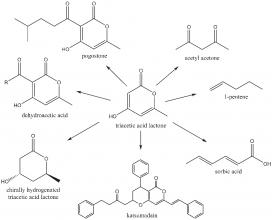CBiRC Established the Potential for Bioprivileged Molecules to Serve as Intermediary Replacements
As the NSF-funded Engineering Research Center (ERC) for Biorenewable Chemicals (CBiRC) at Iowa State University (ISU) continues to pursue generalized technologies that integrate biology and chemistry, it has successfully demonstrated bioprivileged molecules as a new biobased chemical paradigm. Bioprivileged molecules are biologically-derived chemical intermediates that efficiently convert to a diversity of chemical products, including both novel molecules and drop- in replacements. The bioprivileged molecules concept has already formed the basis of an NSF-sponsored workshop in January 2017, as well as an accepted article in the journal, Green Chemistry.
The essential goal of creating biobased chemicals is the production of more sustainable chemicals. However, recent drop in crude oil prices make the commercial prospects of directly replacing petrochemicals with biobased chemicals especially challenging. By producing intermediate biobased chemicals that have the potential to be further converted either to existing chemical products or to novel chemical products with enhanced functional properties, bioprivileged molecules dramatically enhance the commercial viability of biobased chemicals.
Experience in CBiRC and in the emerging commercialization of biobased chemicals suggests that a robust strategy for developing biobased chemicals exists in the generation of an intermediate compound (a bioprivileged molecule) that can be subsequently converted to a number of chemical products including drop-in replacements and novel species. However, previous identification of promising bioprivileged molecules has been largely by chance. Current examples of bioprivileged molecules being commercialized are succinic acid and farnesene.
Within CBiRC, triacetic acid lactone (TAL), coumalic acid and muconic acid have been found to show great promise for biochemical versatility; CBiRC researchers have further demonstrated their ability to leverage intermediates to generate both novel and drop-in chemical products. Additional work remains in developing a framework informed by biological and chemical conversion concepts, as well as end use applications, for systematically determining valuable bioprivileged compounds. Properties of desirable intermediate compounds are expected to include: the capability of being readily converted into a range of useful bioproducts, and the ability to be efficiently generated from biomass precursors.


